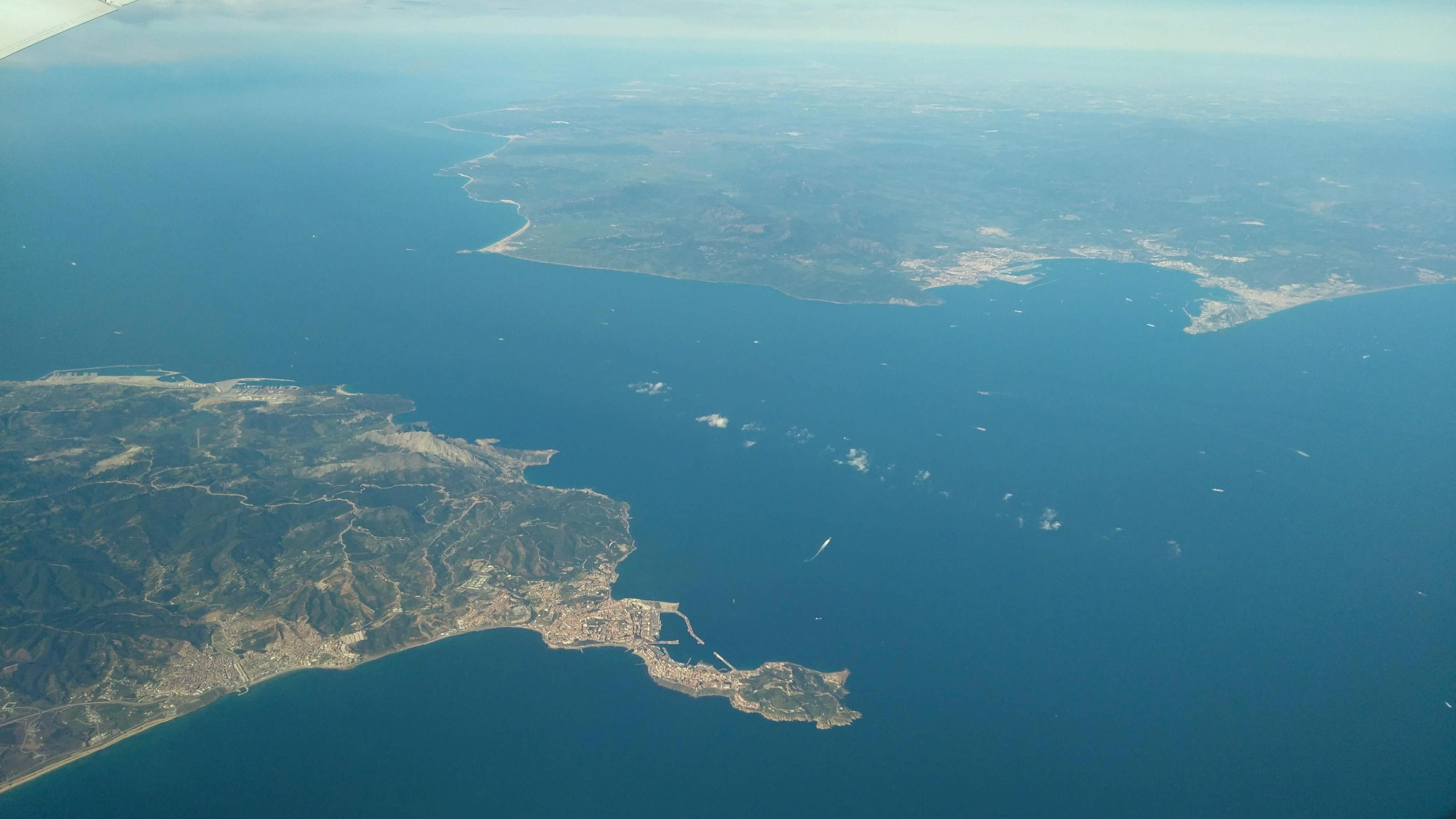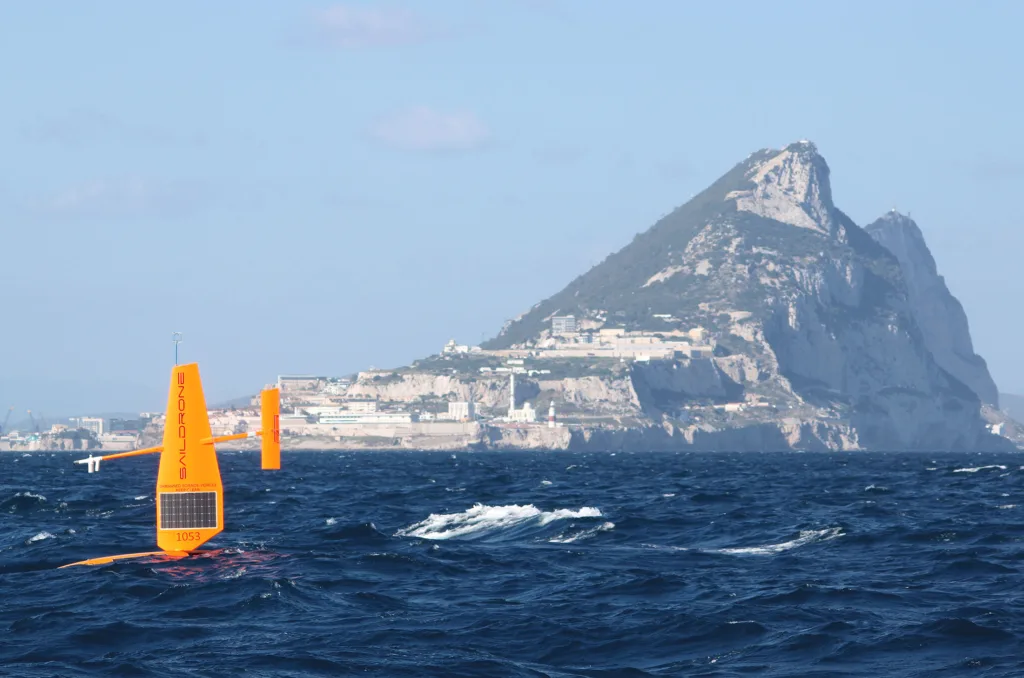The Strait of Gibraltar is a narrow channel of water that connects the Mediterranean Sea with the Atlantic Ocean. It is located between southern Spain and northwestern Africa. The strait is approximately 36 miles long, and it narrows to just 8 miles at its narrowest point between Point Marroquí in Spain and Point Cires in Morocco. The width of the strait varies along its length, with the western (Atlantic) side being about 26 miles wide, and the eastern (Mediterranean) side being approximately 14 miles wide.
The depth of the Strait of Gibraltar ranges from 1,000 to 3,000 feet. The strait is famed for being the closest maritime link between the African and European continents. At just 13 kilometers at its narrowest point, it is posible to see the other end of the strait on a clear day.
The Strait of Gibraltar is a vital shipping lane, with more than 120,000 ships passing through it every year. It is also an important location for tourism, with many visitors coming to see the stunning views of the strait and the surrounding areas.
The strait has played an important role in human history, with evidence of human habitation dating back to prehistoric times. The Phoenicians, Romans, and Moors all used the strait for trade and military purposes. During World War II, the strait was a strategic location for both the Allies and the Axis powers.
In addition to its historical and economic significance, the Strait of Gibraltar is also an important location for biodiversity. The strait is home to a wide variety of marine life, including whales, dolphins, and sea turtles. The area around the strait is also an important bird migration route.
The Strait of Gibraltar is a narrow channel of water that connects the Mediterranean Sea with the Atlantic Ocean. It is approximately 36 miles long, and it narrows to just 8 miles at its narrowest point between Point Marroquí in Spain and Point Cires in Morocco. The strait is an important shipping lane, a popular tourist destination, and a significant location for biodiversity. Its historical and cultural significance cannot be overstated, and its strategic location has made it a key location in many conflicts throughout history.
Dimensions of the Strait of Gibraltar
The Strait of Gibraltar is a narrow passage of water that connects the Atlantic Ocean to the Mediterranean Sea. At its narrowest point, it is only 8 miles wide, making it one of the narrowest straits in the world. The western side of the strait is wider, measuring approximately 26 miles, while the eastern side is narrower, with a width of arond 14 miles.
In terms of depth, the Strait of Gibraltar is known for its variable and complex bathymetry. The depth of the strait ranges from 1,000 to 3,000 feet, with some areas even deeper. The water depth varies due to the complex topography of the seafloor, including underwater canyons, ridges, and valleys.
To summarize, the Strait of Gibraltar is a narrow passage of water that is only 8 miles wide at its narrowest point. The western side of the strait is approximately 26 miles wide, while the eastern side is about 14 miles wide. The depth of the strait ranges from 1,000 to 3,000 feet, with some areas even deeper due to the complex topography of the seafloor.

Source: commons.wikimedia.org
Viewing Across the Strait of Gibraltar
It is possible to see across the Strait of Gibraltar on a clear day. The strait is the narrowest point between the African and European continents, and its width at the narrowest point is only 13 kilometres. Due to its relativly small width, it is possible to see the other end of the strait from either side, assuming clear weather conditions.
However, it’s important to note that visibility may be affected by weather conditions such as fog or haze. Additionally, the distance between the two continents is much greater than just the width of the strait, with the African and European coasts being several hundred kilometres apart.
While it is possible to see across the Strait of Gibraltar, it’s important to keep in mind that visibility may be impacted by a number of factors and that the distance between the continents is much greater than just the width of the strait.
Number of Ships Passing Through the Strait of Gibraltar
The Strait of Gibraltar is a crucial waterway that connects the Atlantic Ocean to the Mediterranean Sea. It is located between the southern coast of Spain and the northern coast of Morocco, and it serves as a gateway between two continents, Africa and Europe.
Every year, more than 120,000 ships pass trough the Strait of Gibraltar, making it one of the busiest shipping lanes in the world. These ships include container ships, oil tankers, passenger ships, and other vessels that transport goods and people between Europe, Africa, and the Americas.
The high volume of ship traffic through the Strait of Gibraltar is due to its strategic location, which allows ships to save time and money by avoiding the longer route around the southern tip of Africa. The Strait is also a popular destination for cruise ships, which offer tourists the opportunity to explore the cultural and natural attractions of the Mediterranean and North Africa.
To ensure safe navigation through the Strait of Gibraltar, the Spanish and Moroccan authorities have established strict regulations and guidelines for ships passing through the area. These regulations include speed limits, traffic separation schemes, and mandatory pilotage for certain types of vessels.
The number of ships passing through the Strait of Gibraltar each year is over 120,000, making it a critical transportation hub for global trade and tourism.
Width of Strait of Gibraltar at Narrowest Point
The Strait of Gibraltar is a channel that connects the Mediterranean Sea with the Atlantic Ocean. It is located between southernmost Spain and northwesternmost Africa, and it is considered a crucial point for maritime traffic between Europe and Africa.
The Strait is 36 miles (58 km) long, and it narrows down to a width of only 8 miles (13 km) at its narrowest point. This narrowest point is located between Point Marroquí in Spain and Point Cires in Morocco.
The width of the Strait of Gibraltar at its narrowest point is significant because it poses a challenge for ships and vessels to navigate through the channel, especialy in adverse weather conditions. The currents in the Strait can be strong and unpredictable, making navigation even more challenging.
Despite the challenges, the Strait of Gibraltar remains a crucial point for international commerce and trade, as well as for military and strategic purposes. The Strait’s unique geographical location has made it a subject of fascination throughout history, and it continues to attract visitors and researchers from all over the world.

Conclusion
The Strait of Gibraltar is not only a beautiful and scenic location but also a crucial waterway for international trade and transportation. Its unique location between two continents, Africa and Europe, makes it a vital gateway for vessels, with over 120,000 ships passing through each year. The channel is only 8 miles wide at its narrowest point and has a depth of between 1,000 and 3,000 feet. With its historical significance and strategic location, the Strait of Gibraltar will continue to play a crucial role in global trade and transportation.
